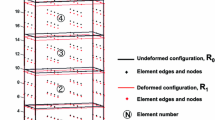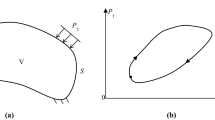Abstract
The life expectancy of a solid component is traditionally predicted by assessing its expected stress cycle and comparing it to experimentally determined stress states at failure. The accuracy of this procedure is often compromised by unforeseen extremes in the loading cycle or material degradation. Residually stressed parts may either have longer or shorter lifespans than predicted. Thus, determination of the current state of stress (i.e., the residual stress in the absence of external loading) and material properties is particularly important. Typically, the material properties of a solid are determined by fitting experimental data obtained from the measured deformation response in the stress-free configuration. However, the characterization of the mechanical behavior of a residually stressed body requires, in principle, a method that is not restricted to specific constitutive models. Complementing a recently developed technique, known as the reversed updated Lagrangian finite element method (RULFEM), a new method called estimating the current state of stress (ECSS) is presented herein. ECSS is based on three-dimensional full-field displacement and force data of a body perturbed by small displacements and complements the first step of the incremental RULFEM method. The present method generates the current state of stress (or residual stress in the absence of external tractions) and the incremental elasticity tensor of each finite element used to discretize the deformable body. The validity of the ECSS method is demonstrated by two noise-free simulation cases.












Similar content being viewed by others
References
Avril S, Bonnet M, Bretelle A-S, Grédiac M, Hild F, Ienny P, Latourte F, Lemosse D, Pagano S, Pagnacco E, Pierron F (2008) Overview of identification methods of mechanical parameters based on full-field measurements. Exp Mech 48(4):381–402
Tartibi M, Steigmann DJ, Komvopoulos K (2014) A reverse updated Lagrangian finite element formulation for determining material properties from measured force and displacement data. Comput Mech 54(6):1375–1394
Withers PJ, Bhadeshia HKDH (2001) Residual stress. Part 1-measurement techniques. Mater Sci Technol 17(4):355–365
Withers PJ, Turski M, Edwards L, Bouchard PJ, Buttle DJ (2008) Recent advances in residual stress measurement. Int J Press Vessels Pip 85(3):118–127
Rossini NS, Dassisti M, Benyounis KY, Olabi AG (2012) Methods of measuring residual stresses in components. Mater Des 35:572–588
Labrosse MR, Gerson ER, Veinot JP, Beller CJ (2013) Mechanical characterization of human aortas from pressurization testing and a paradigm shift for circumferential residual stress. J Mech Behav Biomed Mater 17:44–55
Rodriguez EK, Omens JH, Waldman LK, McCulloch AD (1993) Effect of residual stress on transmural sarcomere length distributions in rat left ventricle. Am J Physiol, Heart Circ Physiol 264(4):H1048–H1056
Wang HM, Luo XY, Gao H, Ogden RW, Griffith BE, Berry C, Wang TJ (2014) A modified Holzapfel-Ogden law for a residually stressed finite strain model of the human left ventricle in diastole. Biomech Model Mechanobiol 13(1):99–113
Holzapfel GA, Ogden RW (2009) Constitutive modelling of passive myocardium: a structurally based framework for material characterization. Philos Trans R Soc, Ser A 367(1902):3445–3475
Waffenschmidt T, Menzel A (2014) Extremal states of energy of a double-layered thick-walled tube – application to residually stressed arteries. J Mech Behav Biomed Mater 29:635–654
Hutchings MT, Withers PJ, Holden TM, Lorentzen T (2005) Introduction to the characterization of residual stress by neutron diffraction. CRC Press, Bocan Raton
Daymond M, Edwards L (2004) Scientific review: ENGIN-X: a fully refined diffractometer designed specifically for measurement of stress. Neutron News 15(1):24–29
Hyde TR, Evans JT, Shaw BA (2000) Effect of stress and heat treatment on magnetic Barkhausen emission in case carburized steels. Mater Eval 58(8):985–990
Buttle DJ, Scruby CB, Briggs GAD, Jakubovics JP (1978) The measurement of stress in steels of varying microstructure by magnetoacoustic and Barkhausen emission. Proc R Soc (Lond), Ser A 414(1847):469–497
Blodgett MP, Nagy PB (2004) Eddy current assessment of near-surface residual stress in shot-peened nickel-base superalloys. J Nondestruct Eval 23(3):107–123
Dobmann G, Buschow K, Cahn R, Flemings M, Ilschner B, Kramer E, Mahaj S, Veyssiere P (2001) Encyclopedia of materials: science and technology. Elsevier, Oxford, pp 5971–5976
Man C-S, Carlson DE (1994) On the traction problem of dead loading in linear elasticity with initial stress. Arch Rational Mech Anal 128(3):223–247
Hoger A (1994) Positive definiteness of the elasticity tensor of a residually stressed material. J Elast 36(3):201–226
Author information
Authors and Affiliations
Corresponding author
Rights and permissions
About this article
Cite this article
Tartibi, M., Steigmann, D.J. & Komvopoulos, K. An inverse finite element method for determining residual and current stress fields in solids. Comput Mech 58, 797–817 (2016). https://doi.org/10.1007/s00466-016-1316-9
Received:
Accepted:
Published:
Issue Date:
DOI: https://doi.org/10.1007/s00466-016-1316-9




